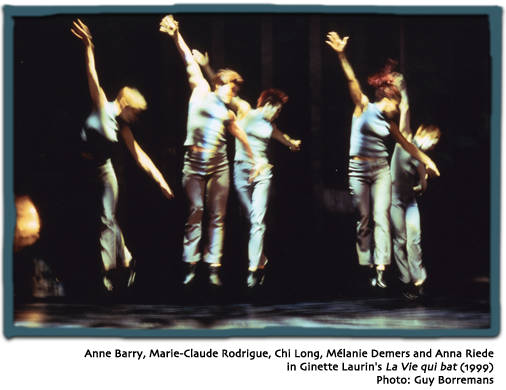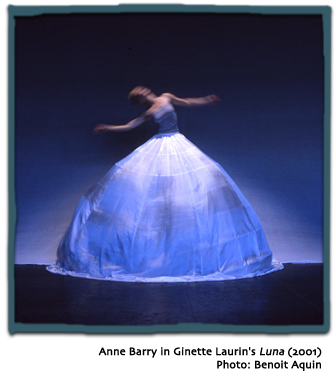Q: I have a question about the film itself in regard to your dance. With the camera work and your editing, even though it's non-literal, how do you determine your flow? Is it different from the stage version?
GL: Yes, it's very, very different!
Q: How did you work with that?
GL: I wanted the camera to be very close to the dancers. I wanted to show something very different. For me it was not important to show the choreography and the whole body all the time. It was a chance to bring the eye of the spectator into some details, and that's what I like with cinema. I can choose for the eye of the spectators. It was important to play with the sensuality of the body and also to play with the gravity of the subject, but in a different way than on the stage. I tried to get closer, as much as I could in the editing, while trying to not lose what's happening in the room. Yes, I would say it's a big pleasure making a film. What's special also in that film, and something that we don't do very often in dance films, is that we recorded the sound. It gives more intimacy …
Q: Like the water dripping …
GL: Yes, and the dancers. All the voices, the steps, their breathing …
Q: The question I have is about the music and about the movement. Often in an enclosed space it's very difficult for us to think of variations on movement and how to choreograph the music to that. How did you use the space and the music together?
GL: Well the space was easy – as I said, we had this set in the studio from the beginning and it really helped. The space is really, really small. You can't imagine how small it is. It's about twenty feet deep and at the front, about twenty-five feet wide, and at the back about fifteen. So it is very, very small for nine dancers; and in the first version we had ten dancers. We had too much movement. We had two hours of choreography and we ended up cutting half and keeping what is essential. Some parts are very quiet. Some other parts are very explosive, crazy; a mix of different improvisations and sections. So it was like making a puzzle.
Q: The music? Was that set to the choreography?
GL: After. For me, the music helps to create the ambiance, rather than scoring the dancers into a timeline.
Q: You've created a number of important works and I'm just wondering why you decided to revisit this particular piece, and why now? And are you going to revisit others again?
GL: In 1992 we wanted to do a film. It was with Rhombus with Niv Fichman. But we didn't find the funding. When someone offered me an opportunity to do it three years ago, I said yes, because I thought this piece would be good using the medium of cinema. And three years ago something happened at Dawson College. We were talking about La Chambre Blanche and I thought, unfortunately this piece can still speak because the subject is still real. That's why we decided to do it. For me it's still a creation because, as I said, I didn't use the video documentation, I just used the structure and revisited each tableau. It was a great pleasure for me to do that; and it's funny because I'm doing it again for another piece which is called La Vie qui bat, a piece I created to Steve Reich's Drumming. This was the first time I made a piece with this music, and we had the musicians on stage. We did it in Montreal with Société de musique contemporaine du Québec, and we perform it now in different cities with the orchestra of that city. Next time we go to Toyko we will perform with an ensemble from Tokyo. This is the second piece I wanted to talk about.

It's the opposite of La Chambre Blanche. It's very formal, and as I said, it was the first time I worked with the music. But we don't count the same way as the musicians and it was quite a challenge for the conductor, because this piece is repetitive. The conductor decides, as they play it, to repeat each phrase the number of times he wants. But for the dance we had to decide in advance how many times for each phrase. We are not together all the time, but we meet at certain points in the piece, so the conductor is very important in the process. Also in performance – because we want to end at the same time! Steve Reich used to say that this piece is a bit like if you were lying down at night in summer and you watched the stars and two hours later you realize that the stars are not in the same place. The changes are very subtle sometimes, and I wanted to do the same thing with the dance – so it's a piece about continuity. Again, I have to structure my piece with a certain space, so I decided to have two different spaces. One space in the middle is for rapidity and one surrounding space is for slowness. So I have those two energies, and I have a wonderful set again, that is just walls. But the space is huge, and I play with transparency. The musicians are behind that set and they appear or disappear at different points with the lighting. The music is in six counts, but we often count differently, so it becomes much slower for us. When it's tricky is when we do one and two and three on their one and four. So we are binary, the music is in triple time and we are in double time. Sometimes it's hard for the dancers to keep going with their rhythm. In another way though, the pulse is so clear and so repetitive and always the same from the beginning to the end that you will fall on that pulse anyway. The hard thing is that for only five minutes through the hour they have to be together – it's a big challenge for my dancers because we never count (laughs).
I wanted that piece to be very urban. We use a lot of pedestrian movements. I also wanted to have a certain unity in the costumes – rather than having different characters like La Chambre Blanche. Maybe we can have a look at the excerpts.
Ginette Laurin's La Vie qui bat (1999)
GL: It's hard to see the continuity because we chopped a lot of moments but I guess you have an idea.
Q: I'm interested in reconstruction, so I have three questions. Has anyone ever tried to notate your work? And when you reconstruct, given that in most cases the music is put on at the end, do you reconstruct in the same way as you choreograph, in terms of letting the dancers learn the movement and then playing the music. Thirdly, has any other company, other than your own, performed your works? Would you give one of your pieces to another company?
GL: In reconstructing La Vie qui bat, I didn't change anything so we had to follow the video. The reconstruction was a long process. I didn't like it very much in terms of the time you spend watching the video and trying to do the same thing. But I have a good memory too, so I could sometimes just forget the video and say, “It's like that; let's try that.” But this process wouldn't be possible for La Chambre Blanche because I wanted each character to be born with each dancer. So that piece would be much easier to remount on another company, I think, but would take a while. I couldn't do it in two weeks, it would take a few months. I think what's hard with that piece is for the dancers to get together and find their own way to listen to the music, to listen to each other in order to be able to perform the work fully.
Q: And what's the year of this piece? Is this your most recent work?
GL: No, this was created in 1999.
Q: Was Ken Gould in the original version?
GL: Yeah, he's not with the company any more.
Q: No, but he's in there.
GL: He's in there. He's the one who's dancing the slow duet with another man.
Q: Anne Barry?
GL: Anne Barry is dancing too, yes.
Q: She was probably in the original too, was she?
GL: Anne? Yes. This film is the original


home l shop dcd l history l links l donations l the collection l services l shipping policy l CIDD l exhibitions l CDFTP
educational resources l visits & lectures l making archival donations l grassroots archiving strategy l personnel l RWB alumni


